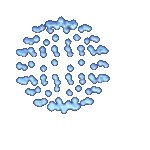
The BSI-MAS is a microbial identification service in the laboratory of Professor Joseph Kloepper. The service has been in operation since 1991 and is performed by John McInroy. The BSI-MAS has the capability of identifying a diverse selection of microbes including environmental and clinical eubacteria, actinomycetes, mycobacteria, anaerobic bacteria, yeasts and some filamentous fungi using the Sherlock System. The Sherlock System is a product of MIDI, Inc. and identification is predicated upon the fact that microbes, especially bacteria have a unique array of fatty acids in their membranes. Pure cultures are subjected to an extraction procedure which involves disrupting the cell wall and membrane, methylating the fatty acids and extracting them with an organic solvent. This collection of fatty acid methyl esters is then analyzed on a fully automated gas chromatographic analytical system. Fatty acid profiles are compared to a database of profiles for over 1000 bacterial species and about 250 fungal species. Results generated by fatty acid analysis include a list of fatty acids present, relative percentage of each as well as microbial identification and fitness of match. The system can analyze about 150 samples per day (or over 1000 per week) allowing for large projects.
Additional capabilities of the Sherlock System include construction of dendrograms and 2-D plot analyses of fatty acid data. These are useful tool in determining strain relatedness and phylogeny.
Broth or agar cultures can be sent, although cultures on agar slants are preferred. The preferred growth medium is trypticase soy agar or nutrient agar. Samples should be clearly labelled with a strain designation. Ship samples to:
| Number of Strains | Price |
| 1-100 | $50.00 each |
| 101 or more | $45.00 each |
| Number of Strains | Price |
| 1-100 | $60.00 each. |
| 101 or more | $55.00 each |
|
|
|
To Services Offered |
|
To Main Page |
 at:
pouncss@auburn.edu
at:
pouncss@auburn.edu